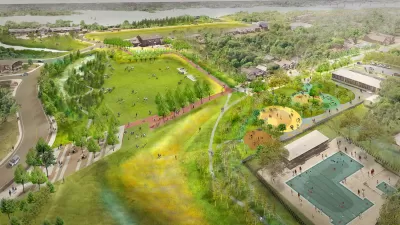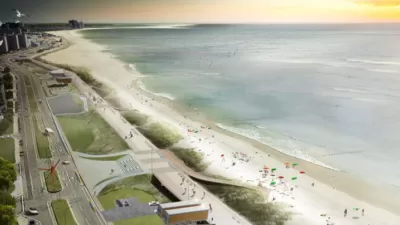A new flood plan for Norfolk, Virginia aims to establish a new model for coastal resilience.
Ryan Murphy reports on the recently unveiled plan to fortify the neighborhood of Chesterfield Heights in Norfolk, Virginia, from coastal erosion and sea-level rise.
"[The] ambitious $112 million federally funded plan — the final version of which was unveiled last week — aims to halt the advance of the water and keep Chesterfield Heights dry for decades to come, as Norfolk faces down an estimated 2½ feet of sea level rise within 50 years," according to Murphy.
The plan, called the Ohio Creek Watershed Project, expanded beyond the original plan to build a series of seawalls and five drainage pumps. Murphy explains the changes since earlier versions of the plan:
Softer options like earth berms replace hardened sea walls. The berms, several feet high in some places, will be easier to update and reinforce than a traditional concrete structure — just toss some more dirt on it.
And
Ohio Creek is tidal and will flood and drain freely, as it always has. But Hayes Creek right next door will have a tide gate that can be dropped at low tide when a storm is coming. The creek and its wetlands will serve as a basin, collecting rainwater rather than letting it flood neighborhood streets. Then the gate will reopen after the storm to let the water drain out to sea.
The idea for the plan is also to export the knowledge gained from the plan's new and varied approaches to cities and communities in other parts of the country.
FULL STORY: Norfolk's $112 million flooding plan will fortify one neighborhood — and test other solutions

Study: Maui’s Plan to Convert Vacation Rentals to Long-Term Housing Could Cause Nearly $1 Billion Economic Loss
The plan would reduce visitor accommodation by 25,% resulting in 1,900 jobs lost.

North Texas Transit Leaders Tout Benefits of TOD for Growing Region
At a summit focused on transit-oriented development, policymakers discussed how North Texas’ expanded light rail system can serve as a tool for economic growth.

Using Old Oil and Gas Wells for Green Energy Storage
Penn State researchers have found that repurposing abandoned oil and gas wells for geothermal-assisted compressed-air energy storage can boost efficiency, reduce environmental risks, and support clean energy and job transitions.

From Blight to Benefit: Early Results From California’s Equitable Cleanup Program
The Equitable Community Revitalization Grant (ECRG) program is reshaping brownfield redevelopment by prioritizing projects in low-income and environmental justice communities, emphasizing equity, transparency, and community benefits.

Planting Relief: Tackling Las Vegas Heat One Tree at a Time
Nevada Plants, a Las Vegas-based nonprofit, is combating the city’s extreme urban heat by giving away trees to residents in underserved neighborhoods, promoting shade, sustainability, and community health.

How Madison’s Tree Planting Efforts Are Growing a Healthier Community
Madison’s annual tree planting initiative is enhancing environmental resilience, public health, and community livability by adding 1,400 carefully selected trees citywide, with strong community and institutional support for urban forestry.
Urban Design for Planners 1: Software Tools
This six-course series explores essential urban design concepts using open source software and equips planners with the tools they need to participate fully in the urban design process.
Planning for Universal Design
Learn the tools for implementing Universal Design in planning regulations.
Ascent Environmental
Borough of Carlisle
Institute for Housing and Urban Development Studies (IHS)
City of Grandview
Harvard GSD Executive Education
Toledo-Lucas County Plan Commissions
Salt Lake City
NYU Wagner Graduate School of Public Service




























